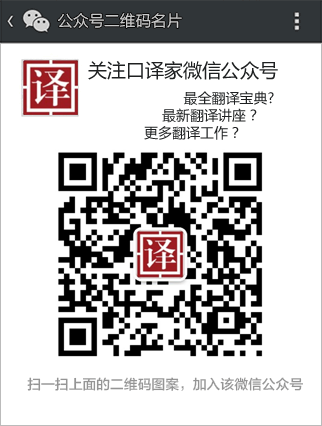全国外语翻译证书考试(NAETI)英语一级口译考试真题(5)
全国外语翻译证书考试(NAETI)英语一级口译考试真题(5)
同声传译录音稿
Section 2: Simultaneous Interpreting
Part 1: English to Chinese
In the first part of the test, you will hear a speech delivered in English by Dr. Robert, President of US-China Business Council at Xiamen Trade and Investment Fair. Please turn the speech into Chinese while the speaker speaks.
Let’s begin. [TONE]
Ladies and Gentlemen:
I am very grateful for the chance to meet with you this day. The credit — or the blame – for my being here belongs to Vice Minister Ma. She is very persuasive, and I found it easy to accept her kind invitation to participate in this year’s events. She also urged me to bring with me to Xiamen representatives of some of our US-China Business Council’s member companies, and I am pleased that we could do so. I hope that everyone in the audience this morning will have a change to get acquainted with these experienced business friends – Mr. Patrick Powers, our Council’s Director of China Operations, based in Beijing, and Mr. Dennis Chen.
In the brief time available today, I would like to offer five observations.
1.From the standpoint of foreign investment, China is already a success story.
Anyone who remembers that Deng Xiaoping was once criticized for suggesting that China should study German shipbuilding methods in order to improve its own; anyone who remembers Deng’s moving speech to the National Science Conference in the spring of 1978, in which he declared that science was a world heritage from which China should draw and to which China must contribute; anyone who remembers that foreign investment was almost completely absent from China little more than twenty years ago – such a person, like me, will understand how much China accomplished in the next two decades.
China now ranks first as a recipient of foreign direct investment on an annual basis. Millions of people have risen from absolute, grinding poverty. Those achievements are important, and they can be measured. But the numbers are only part of the story.
Beyond the quantitative measures are the vital “accompanying factors.” Market principles have taken root within the economy and within most enterprises. A labor market has emerged, providing a degree of occupational choice to millions of Chinese citizens who formerly had no choice as to how they would earn their livings. The amount and quality of information available to China’s citizens has improved in many sectors. Legal concepts and practices unknown to nearly all Chinese 25 year ago are gradually entering the lives of the people, their workplaces, and students have reached fully into the world. Technology imports and domestic technology development have been successfully linked with effective managerial skill and a hard working labor force to create a vast and rapidly growing industrial economy oriented to world markets, world standards, and global needs.
Opening its doors to international investment, China has created a foreign-invested export economy that not only brings capital and technology into the country, but by providing more than half of China’s overall exports raises foreign exchange needed for the purchase of items that a modernizing China cannot better provide for itself. By joining the World Trade Organization on demanding but ultimately beneficial terms, China has reaffirmed its determination to continue the process of economic reform and integration with global commercial practices. That decision, together with China’s impressive rates of economic growth and the emergence of a large domestic market, has further encouraged foreign to come to integrate China into their global business strategies.
China has, as we say in casual American English, “arrived.” The language of global business is increasingly the language of China’s engagement with the world. The gleaming cities and sprawling industrial parks of China are proof for the world to see.
2.That “success story.” However, has created its own dislocations, and for many inside China the “success” is far less obvious.
The dislocations are well known. If more than half of China’s foreign trade is accounted for by foreign invested firms, then less than half of this great nation’s trade is accounted for by domestically-developed companies; the disproportion is self evident. The assimilation of foreign companies and products into the fabric of the Chinese economy has been uneven, so that in some fields foreign brands almost completely dominate China’s market while in other fields struggles aiming to protect or nurture Chinese-made products by directly or indirectly making foreign companies’ progress more difficult continue to this day.

(责任编辑:秩名)
- 翻译公司告诉你产品广告翻译的要领[ 18-07-14 ]
- 浅谈医学论文摘要翻译攻略[ 18-07-13 ]
- 中国法庭口译的特点有哪些?[ 18-07-10 ]
- 翻译公司告诉你出国留学需要翻译的[ 18-07-09 ]
- 如何找到专业学历认证翻译机构[ 18-07-07 ]
- 商务英语的特点有哪些?[ 18-07-06 ]
- 汽车翻译从业人员的要求有哪些?[ 18-07-05 ]







